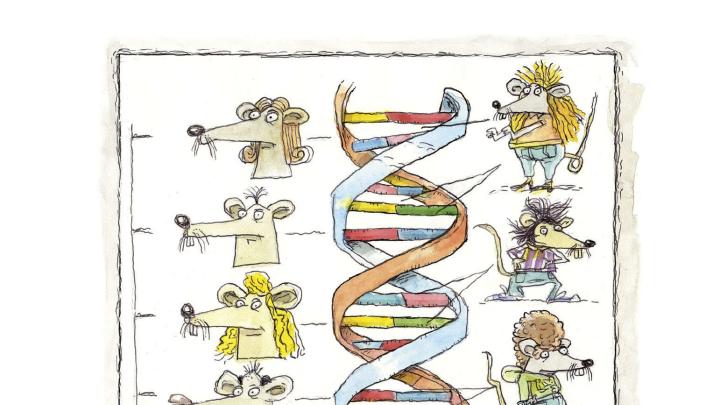As the first modern humans made their way out of Africa, about 100,000 years ago, they experienced a range of regionally specific selective evolutionary pressures (related to climate, diet, and disease risks) that slowly shaped the differences seen among human populations today. Until now, efforts to link these adaptive traits to specific genes have been limited to a handful of mutations with a single, easily measured effect, such as skin pigmentation or lactose tolerance. Yet scientists know that most genes are pleiotropic—they influence multiple characteristics. A recent study published in Cell has isolated the effects of just such a complex human gene by using, for the first time, a mouse model. The experiment has demonstrated the potential for using mice to discover and analyze the evolution of adaptive traits responsible for human variation.
The researchers—an interdisciplinary group from the Faculty of Arts and Sciences (FAS), Harvard Medical School (HMS), The Broad Institute (of MIT and Harvard), Massachusetts General Hospital (MGH), and colleagues in China and the United Kingdom—focused on an East Asian variant of the ectodysplasin receptor gene, EDAR. That gene is involved in the development of a wide range of skin-related organs—hair, glands, and teeth—as well as feathers in birds, fur in mammals, and scales in fish. The mutation, EDAR370A—estimated to have arisen in central China approximately 30,000 years ago—was known to produce thicker hair and changes in tooth shape among East Asian populations, but the full range of its associated traits had yet to be identified. The investigators hoped that by testing the variant’s effects in a mouse they might learn how and why the mutation proved advantageous to early humans settling in China.
The study evolved out of a broader discussion about the origins of human skin and its unique role in thermoregulation. Professor of human evolutionary biology Daniel Lieberman and Leder professor of genetics Clifford Tabin, chair of the HMS department of genetics, shared an interest in how the evolution of human sweat glands and of hair (in place of heat-trapping fur) had given humans an endurance advantage over faster, stronger mammals. “We hoped to come up with a way to understand at a gene level how that transition from apes to humans might have occurred, to allow us to become man, the jogger,” Tabin recalls. To that end, they recruited professor of dermatology Bruce Morgan and computational geneticist Pardis Sabeti, associate professor of organismic and evolutionary biology and a senior associate of the Broad Institute.
Sabeti’s lab at the Broad had previously identified the East Asian EDAR variant as a gene under recent positive selection, making it a good starting point for the collaborative investigation. She had developed a technique, called the “composite of multiple signals,” that enables researchers to tease out the precise gene on a given area of the genome that has causal significance for selection, unlike nearby genes that are “just along for the ride.” Once the EDAR variant was isolated, she and her colleagues were able to determine the mutation’s age and place of origin by looking at the distribution and genomic context in which it occurs in present-day populations, and then applying computer regressions.
To test the evolutionary significance of the EDAR mutation, the team decided to replace a mouse’s normal EDAR gene with EDAR370A and brought in lead author Yana Kamberov, an HMS research fellow in genetics, to conduct the experiment. “Mice make it easier to do a complete analysis,” she says, “because you can eliminate all other variation in the genome, isolating the mutation’s effects.” Still, no one knew whether the changes would actually be detectable in a mouse. “People assumed that human variation is so subtle that the differences between humans would be swamped by the difference between humans and mice,” Tabin says.
In fact, the mouse model displayed not just thicker hair follicles, but also a number of previously unknown characteristics, including increased sweat glands and smaller mammary fat pads. Participating researchers in China have so far verified the hair and sweat-gland traits in a cohort of Han Chinese carriers of the gene. (Changes in human teeth have no direct corollary in mice.)
The results have generated new hypotheses about the EDAR variant’s adaptive value for the earliest East Asians. “It’s unlikely there was a single selective pressure,” Tabin points out. More likely, he says, different aspects of the mutation were important at different times. Increased sweat glands may have benefited those humans adapting to a series of climatic shifts that took place in central China; smaller mammary fat pads could have provided an energy-saving advantage. But positive selection for this mutation clearly persisted, even as people migrated to colder, drier places.
So how and why was the selection maintained? Bruce Morgan suggests that there may have been a developing cultural preference for visible traits such as thick hair and smaller breasts that reinforced the biological advantage of sweating. “In one sense,” he says, “this gene is simple” (because everything it does is related to the skin), “but in another sense it’s complicated” (because it affects so many skin-related traits).
The cross-disciplinary team will continue their collaboration, trying to answer some of the many questions their study has unearthed. “We are still a long way from answering our initial question: why did humans lose fur and develop sweat glands?” Lieberman says. “But we’ve discovered some exciting links…and we’re not giving up.”








